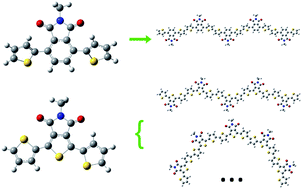Effect of polymer chain conformation on field-effect transistor performance: synthesis and properties of two arylene imide based D–A copolymers†
Abstract
Two donor–acceptor (D–A)

* Corresponding authors
a
Department of Chemistry, Hubei Key Lab on Organic and Polymeric Optoelectronic Materials, Wuhan University, Wuhan 430072, China
E-mail:
jgqin@whu.edu.cn
Tel: +86-27-68752330
b
Beijing National Laboratory for Molecular Sciences, Institute of Chemistry, Chinese Academy of Sciences, Beijing 100190, China
E-mail:
liuyq@iccas.ac.cn
Tel: +86-10-62613253
Two donor–acceptor (D–A)

 Please wait while we load your content...
Something went wrong. Try again?
Please wait while we load your content...
Something went wrong. Try again?
D. Chen, Y. Zhao, C. Zhong, S. Gao, G. Yu, Y. Liu and J. Qin, J. Mater. Chem., 2012, 22, 14639 DOI: 10.1039/C2JM31755A
To request permission to reproduce material from this article, please go to the Copyright Clearance Center request page.
If you are an author contributing to an RSC publication, you do not need to request permission provided correct acknowledgement is given.
If you are the author of this article, you do not need to request permission to reproduce figures and diagrams provided correct acknowledgement is given. If you want to reproduce the whole article in a third-party publication (excluding your thesis/dissertation for which permission is not required) please go to the Copyright Clearance Center request page.
Read more about how to correctly acknowledge RSC content.
 Fetching data from CrossRef.
Fetching data from CrossRef.
This may take some time to load.
Loading related content
